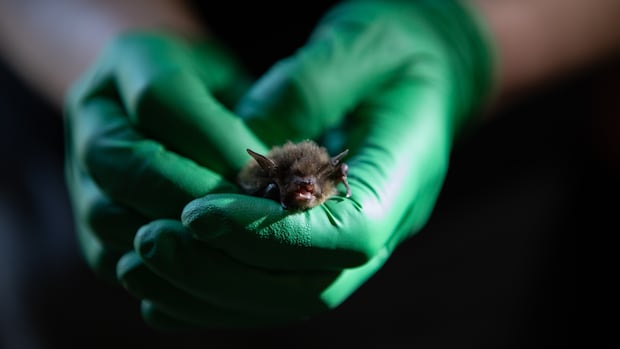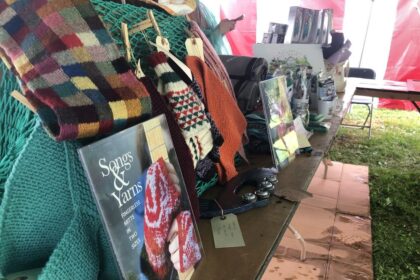As night falls over a large country house in Washington state’s Snohomish County, a dozen volunteers gather around Abby Tobin, a scientist with the Washington State Department of Fish and Wildlife. “They’ll start getting restless soon,” Tobin says.The group is attentive as Tobin gives instructions. Their mission is as follows: catch as many bats as possible.They’re looking for signs of the fungus that causes white-nose syndrome, which has been decimating bat populations in eastern North America over the last 15 years or so.Abby Tobin instructs volunteers to catch as many bats as possible, with the ultimate goal of saving them from a deadly fungus that has destroyed populations in eastern Canada. (Genevieve Lasalle/Radio-Canada)The fungus, known as Pseudogymnoascus destructans, infects bats’ skin, according to the Canadian Wildlife Health Cooperative, and disturbs hibernation, resulting in dehydration, starvation, and ultimately, death.But B.C.-based scientist Cori Lausen, nicknamed Bat Lady by her peers, believes a probiotic formula may be capable of saving them.Research scientist Cori Lausen is studying probiotics as a treatment for white-nose syndrome (Camille Vernet/Radio-Canada)According to the B.C. government, white-nose syndrome has killed more than six million bats in eastern North America since 2006. “We see very few bats flying in Quebec now,” says Anouk Simard, a biologist with Quebec’s Ministry of the Environment, the Fight Against Climate Change, Wildlife and Parks.”[Groups] that were around 1,000 to 5,000 individuals, after a few years, there were zero,” Simard says. “I remember visiting a cave that normally had 300 individuals, there were two inside.”WATCH | B.C. scientist working to save bats from deadly fungus:A B.C. scientist may have the remedy for a fungus affecting Canada’s batsWhite-nose syndrome has already decimated bat populations across eastern Canada. Now, as the fungal disease threatens to spread west, one scientist is fighting back with a probiotic ‘cocktail. CBC’s Camille Vernet went to meet the scientist and the bats she wants to protect.Winter approachingWhite-nose syndrome has been detected in Alberta, B.C.’s neighbouring province, and in Washington state to the south. It’s been found in guano (bat poop) under a bridge in Grand Forks, B.C., Lausen says, but it has not yet been detected in bats in British Columbia. It’s during the winter, when bats hibernate together, that the symptoms of white-nose syndrome develop, Lausen says.If a significant number of bats die out as a result of white-nose syndrome out west, there could be serious consequences. Bats are formidable natural pest control agents; in one night, a bat can eat up to its own body weight in insects, Lausen says. According to Parks Canada, that could be about 600 bugs an hour, including pests like mosquitoes. And because they devour insects at such a rate, they reduce the need for pesticides, which saves farmers money, reduces pollution and benefits food security, Parks Canada says. WATCH | Why bats are so important in B.C.:Why bats are crucial to the ecosystemBats — with their nocturnal habits and eerie reputation — tend to fly under the radar, with their vital role in ecosystems often overlooked. Cori Lausen, the director of Bat Conservation at the Wildlife Conservation Society of Canada, talks about the challenges the misunderstood mammals face in B.C. According to a study published in the academic journal Science in 2024, the human infant mortality rate could increase by eight per cent in regions affected by white-nose syndrome. The theory behind it is that when bat populations decline, farmers increase their use of pesticides, which are toxic compounds that affect human health.This is a correlation, not a direct causality, but the data shows a strong link, Lausen says. White-nose syndrome isn’t the only threat looming; habitat loss linked to deforestation is a particular concern for the scientist, as is the use of wind turbines, which Lausen says are killing migratory bats in large numbers.It’s for these reasons that Lausen is determined to save the bats. Cori Lausen has made it her mission to save bats from white-nose syndrome, among other threats to their existence. (Camille Vernet/Radio-Canada)The cocktailIn B.C., 40 kilometres from the U.S. border, defences are being strengthened as winter approaches. Lausen is at the Hayward Recreation Site near Stave Lake spraying the probiotic �“cocktail” she’s developed into bat roosts. This cocktail is a blend of four bacterial strains that suppress the fungus. These bacteria are naturally found in some bats, but not all. Cori Lausen holds the probiotic ‘cocktail’ that could hold the key to protecting bats from white-nose syndrome. (Camille Vernet/Radio-Canada)”I call it the Robin Hood approach,” Lausen says. “We’re literally taking from the bats that have the good bacteria and making sure that all the bats get good bacteria as well.”Whether the probiotic is working is still being studied, but Lausen says early evidence is “very promising.”“We are getting some very positive results that do suggest our probiotic is helping bats fight off this fungus.”Cocktail vs. fungusBack in Snohomish County, applause erupts among the volunteers at the mention of Lausen. The Canadian scientist’s work has won the hearts of American researchers, who have been testing her cocktail’s effectiveness since 2022.At this so-called control site, the probiotic cocktail is not being spread, but rather, the bats will be examined to see if they have symptoms of white-nose syndrome and if they carry traces of the probiotic cocktail.Even if this particular colony has not been treated with the protective solution, the probiotic bacteria might have been transmitted through contact with another colony. The team dons white coveralls, goggles, and gloves — protective measures against rabies, but also to limit the transmission of the fungus.The volunteer team prepares a net to catch bats in Snohomish County. (Genevieve Lasalle/Radio-Canada)The team stretches out poles to install a large net in front of the home’s solarium door. They feverishly scan the darkening sky and soon, the first bat emerges, diving straight into the net’s fine mesh.A volunteer rushes to the net and unhooks the animal, placing it in a small bag. The process is repeated at a frenetic pace and, in total, about twenty bats are captured.A bat is caught in a net so that researchers can analyze it, and check for white-nose syndrome or the presence of a probiotic that may protect it against the fungus. (Genevieve Lasalle/Radio-Canada)On a mobile laboratory table, each bat’s data is collected, including things like their sex and approximate age.Tobin runs a cotton swab over the wings of a temporarily captive bat, noting some white spots. “Over here looks more suspicious of white-nose damage,” she explains. Researchers run a cotton swab over a bat’s wing to determine whether it has the fungus that causes white-nose syndrome. (Genevieve Lasalle/Radio-Canada)The white spots are a reminder that the threat these bats face is very real. Once she’s gathered the information she needs, Tobin releases the bat back into the sky. ‘They’ll just die underground’It will take several months for the results of the information gathering to be known. Lausen worries that if biologists don’t identify a treatment soon, the bats in the west will die off without anyone noticing until it’s too late. A volunteer scientist detaches a bat from a net. (Genevieve Lasalle/Radio-Canada)In eastern Canada, she said, bats hibernate all together and scientists can walk into a cave and count dead bats. But here, it’s not so easy. Western bats prefer to hide in small groups, underground and in trees, Lausen says, making them tough to find and diagnose. “If they’re just getting into the ground to hibernate, then we won’t see the impacts of white nose syndrome because they’ll just die underground,” Lausen says.“We won’t know that the bats are dying off.”
As white-nose syndrome threatens bats nationwide, this scientist’s probiotic cocktail could save them











